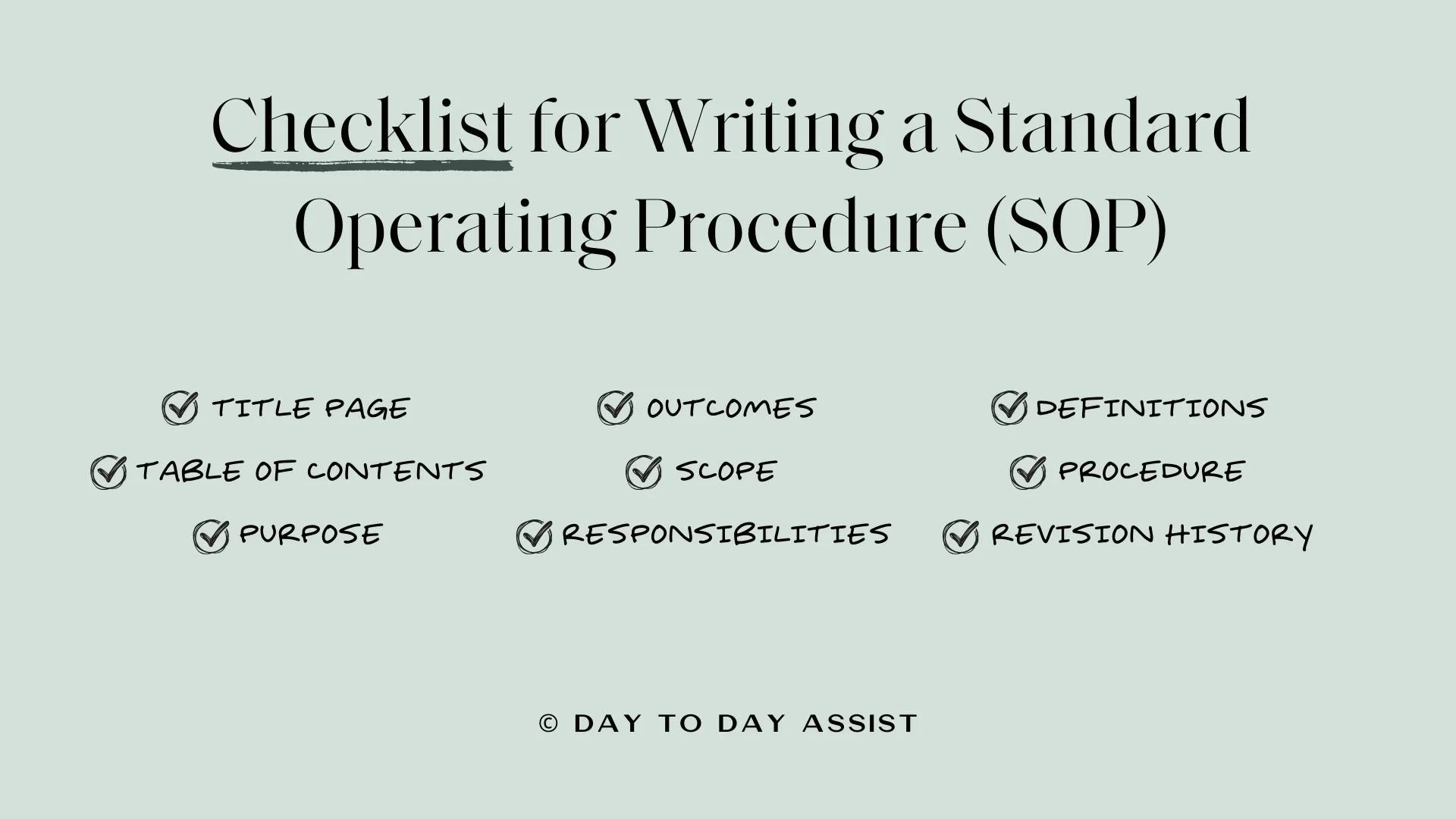How to Write A Standard Operating Procedure for Your Small Business
One of the best parts of running a small business is the teamwork and collaboration that come with working toward a shared goal. In big corporations, employees can spend years in the same role without ever meeting people from other departments. But in a small business, sales and marketing might not just work together—they could be the same person.
That close-knit environment is great, but it’s not a reason to skip documenting your processes. Even in a well-run business, important details can slip through the cracks, leading to missed opportunities and unnecessary chaos. Putting standard operating procedures (SOPs) in place keeps everything running smoothly, ensuring that everyone follows the same game plan and stays focused on what matters most.
What is a Standard Operating Procedure (SOP)?
A standard operating procedure (SOP) is a step-by-step guide that lays out how to complete a specific task in a business. It helps employees follow a clear process, so they know exactly what to do and how to do it.
Most businesses have multiple SOPs to cover different tasks—like responding to clients, hiring new employees, managing budgets, or handling invoices. The main purpose of an SOP is to keep things running smoothly by cutting down on confusion and making sure everyone is on the same page.
Why Should Your Small Business Have a Standard Operating Procedure?
A lot of small business owners assume their team just knows how to handle daily tasks, so they skip creating SOPs. But even in a small team, things can slip through the cracks—leading to miscommunication, inconsistent service, and wasted time. Without clear processes, you’re relying on memory and assumptions instead of a solid system.
SOPs take the guesswork out of running your business. They make it easier to train new hires, keep things running smoothly, and deliver a consistent experience to your clients. Plus, when you're ready to scale, having documented processes in place will make growth way less chaotic.
Here are 4 key SOPs every small business needs:
Team Recruiting & Onboarding SOP
Hiring the right people is just the start—how you onboard them determines whether they’ll succeed in their role. A recruiting and onboarding SOP standardizes your hiring process, interview steps, and training plan so every new hire gets the support they need to be productive. This SOP should cover job posting guidelines, interview procedures, onboarding checklists, and performance expectations to ensure consistency and improve retention.
Client Relationship Management SOP
Delivering a great service is only part of the client experience—how you engage with them before, during, and after a project matters just as much. A client relationship SOP should outline your onboarding process, communication standards, service delivery workflow, and follow-up strategy. This ensures every client gets a seamless experience, reducing miscommunication and increasing referrals and repeat business.
Marketing & Sales SOP
Without a structured approach, marketing efforts can be inconsistent, and sales opportunities can be missed. An SOP for marketing and sales helps define lead generation strategies, sales workflows, content calendars, and brand messaging guidelines. This keeps marketing efforts focused and ensures every sales conversation aligns with your business goals.
Internal Project & Task Management SOP
Juggling multiple client projects and internal tasks can quickly get overwhelming without a clear system. A project management SOP should define how work is planned, assigned, tracked, and completed. It should cover your task management tools, communication expectations, deadlines, and accountability measures to keep operations running smoothly.
Here’s The Bottom Line…
SOPs aren’t just about documentation—they create efficiency, reduce mistakes, and ensure consistency as your business grows. By outlining clear processes for key areas like hiring, client management, marketing, and internal projects, you’ll build a more organized and scalable business.
What Processes Don’t Need an SOP?
Not everything in your business needs to be documented—some things just don’t require a step-by-step breakdown.
Here’s when you can skip creating an SOP:
Basic Tasks That Can Be Googled – Don’t overcomplicate things. If a task is straightforward—like sending an email or scheduling a social media post—there’s no need for a formal SOP unless your business has a unique way of doing it.
Processes Without a Clear Purpose – Every SOP should have a clear goal, like improving employee retention or ensuring a seamless client experience. If a process doesn’t contribute to a measurable outcome, it’s probably not worth documenting. Overloading your team with unnecessary SOPs can feel like micromanagement and slow things down instead of helping.
SOPs should work for your business, not create more busywork. Focus on documenting the processes that truly impact efficiency, consistency, and growth.
How to Write a Standard Operating Procedure (SOP) for Your Small Business:
Before you start writing an SOP, think about what you actually need. Are you giving step-by-step instructions? Setting guidelines? Outlining best practices? The format you choose depends on the process and how flexible it needs to be. Here’s a breakdown:
Step-by-Step Instructions
These are your do-this-exactly-like-this-every-time SOPs. Think of it like a recipe—if you follow the steps, you get the same apple pie every time, no matter who bakes it. If a process needs to be done the same way to get a consistent result, you’ll want to include things like bullet points, numbered lists, and checklists.
Examples:
Event planning checklists
Campaign launch procedures
Invoice processing
Equipment maintenance
Guidelines for Flexible Processes
Some processes can’t (and shouldn’t) be done the same way every time. A sales call, for example, isn’t a script—it’s a conversation. Instead of strict steps, these SOPs should focus on outcomes. What do you need to happen by the end? A guideline-based SOP for sales might require team members to log details after every call—things like client budget, demographics, and follow-up dates. The goal is to build a useful client profile, not force reps into robotic conversations.
Examples:
Sales and lead qualification
Social media engagement
Handling complaints
Best Practices for Creative Work
Not every process should be rigid. If you’re working with creatives—like designers, copywriters, or marketers—overly structured SOPs can limit innovation. Instead, best practices set clear expectations while leaving room for creativity. A graphic design team might follow a brand style guide, but they still have freedom to create. A catering company might allow recipe experimentation but within a set budget and flavor profile. A marketing team might establish a consistent brand voice across platforms without dictating every single word.
Examples:
Brand style guides for copywriters and designers
Recipe development guidelines for a catering business
Tone and messaging guides for marketing teams
No matter what type of SOP you’re creating, the key is to make it useful. The goal isn’t to overwhelm your team with rules—it’s to create clarity, consistency, and efficiency so your business runs smoother.
Your SOP Checklist: Here’s What to Include:
Not sure what to put in your SOP? Here’s a simple checklist to make sure it’s clear, effective, and actually useful for your team:
Title Page – Start with the basics. What process are you documenting? Who wrote it? Which department is it for? When does it go into effect? This keeps everything organized and easy to reference.
Table of Contents – If your SOP is more than a couple of pages, add a table of contents so people can quickly find what they need. Use clear section titles to make navigation easy.
Purpose – Why does this SOP exist? Spell out what it’s meant to accomplish. For example, if it's a marketing SOP, the purpose might be to keep messaging consistent across platforms.
Outcomes – What should happen when this SOP is followed? Will your sales team have stronger client data? Will your marketing calendar be planned a month in advance? Make sure the result is clear.
Scope – Define who this SOP applies to and any limits it has. Is it just for the sales team? Only for full-time employees? Set those boundaries upfront.
Responsibilities – Who’s in charge of what? List out roles and responsibilities so there’s no confusion about who owns each step of the process.
Definitions – If your SOP includes any industry jargon, acronyms, or technical terms, explain them here. This is especially helpful for onboarding new team members.
Procedure – This is the heart of the SOP. Break down the process into clear, step-by-step instructions. Use bullet points, checklists, flowcharts, or even videos—whatever makes it easiest to follow.
Revision History – SOPs aren’t set in stone. Keep track of updates by noting when changes were made, who made them, and what was updated.
A good SOP should be easy to follow, useful, and actually help your team get work done. Keep it simple, clear, and focused on results!
Take the Guesswork Out of SOPs and Build a Business That Runs Itself
Writing SOPs is just one piece of the puzzle when it comes to running a smooth, scalable business. The real magic happens when you have the right systems, tools, and processes in place to keep everything running without you having to micromanage. Whether you need fully documented procedures, a clear roadmap to fix your backend operations, or expert guidance to help you set up efficient systems, we’ve got a solution for you.
Here’s how we can help:
Book Our Done-For-You Systems Service [HERE] – We’ll fix the nagging operations problems your business has been struggling with by simplifying processes, setting up the right tech tools, and documenting all procedures—SOPs included. In just two months, you’ll have a business that runs smoothly without you getting caught up in the day-to-day.
Book Operations Consulting [HERE] – Not ready for a done-for-you service? We’ll audit your current systems and give you step-by-step instructions to get everything running efficiently. Whether it’s creating SOPs, streamlining workflows, or optimizing tech, you’ll walk away with a clear action plan.
Join the Systems for Solo CEOs Advisory [HERE] – If you’re growing your business solo and need to refine your operations, this program is for you. You’ll learn how to set up effective processes, choose the right tech tools, and make smart hiring decisions. Plus, you’ll get access to expert guidance to help you implement everything.
No more reinventing the wheel every time you onboard a new team member, deliver a service, or manage a project. Let’s get your business running like a well-oiled machine. Choose the support level that works best for you and start building a business that scales!



















Turn leads into clients with Interact’s quiz software. Create a lead magnet quiz that engages, qualifies, and matches clients to the right service – fast.